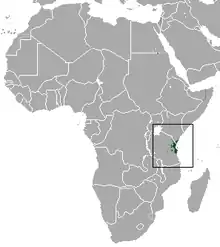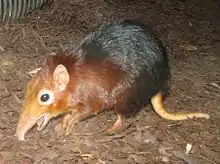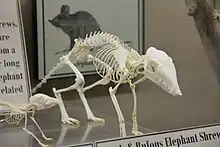| Black and rufous elephant shrew | |
|---|---|
 | |
| Scientific classification | |
| Domain: | Eukaryota |
| Kingdom: | Animalia |
| Phylum: | Chordata |
| Class: | Mammalia |
| Order: | Macroscelidea |
| Family: | Macroscelididae |
| Genus: | Rhynchocyon |
| Species: | R. petersi |
| Binomial name | |
| Rhynchocyon petersi Bocage, 1880 | |
 | |
| Geographic range | |
The black and rufous elephant shrew[2] (Rhynchocyon petersi), the black and rufous sengi,[1] or the Zanj elephant shrew[3] is one of the 17 species of elephant shrew found only in Africa.[2] It is native to the lowland montane and dense forests of Kenya and Tanzania.[4] Like other members of the genus Rhynchocyon, it is a relatively large species, with adults averaging about 28 cm (11 in) in length and 450–700 g (16–25 oz) in weight.
Distribution and habitat
.png.webp)
The forests of the Eastern Arc Mountains are critical habitats for R. petersi.[5] The Chome Forest Reserve in Tanzania is an isolated, and largely undisturbed, habitat for the shrews.[5] Populations densities in the Chome area are significantly lower than the surrounding areas, home to approximately 2700 R. petersi, and is thought to be the result of restricted migration and illegal human activity.[5] It was once listed by the IUCN Red List as vulnerable, but has since been changed to a status of least concern.[1] However, its numbers are reportedly declining; suffering from severe forest fragmentation and degradation from human expansion.[6]
Diet and behaviour

It eats insects such as beetles, termites, and centipedes, using its proboscis to dig them from the soil and its tongue to lick them up.[7] Like most elephant shrews, it lives in monogamous pairs, defending hectare-sized territories.[8][9] It typically builds ground level nests for shelter[9] requiring dry leaf litter[3] often at the base of trees.[5]
Elephant shrews in zoological gardens
Several zoos have begun breeding this elephant shrew, including seven in Europe,[10] such as the Prague and Wrocław zoos, as well as zoos in the United States like the Philadelphia Zoo. Two black and rufous elephant shrew males were born on February 4, 2007, at the National Zoo in Washington, D.C.
References
- 1 2 3 Hoffmann, M.; Burgess, N.; Rovero, F. (2016). "Rhynchocyon petersi". IUCN Red List of Threatened Species. 2016: e.T19708A21286959. doi:10.2305/IUCN.UK.2016-1.RLTS.T19708A21286959.en. Retrieved 18 November 2021.
- 1 2 Schlitter, D.A. (2005). "Order Macroscelidea". In Wilson, D.E.; Reeder, D.M (eds.). Mammal Species of the World: A Taxonomic and Geographic Reference (3rd ed.). Johns Hopkins University Press. p. 85. ISBN 978-0-8018-8221-0. OCLC 62265494.
- 1 2 Norbert J. Cordeiro; Nathalie Seddon; David R. Capper; Jonathan M. M. Ekstrom; Kim M. Howell; Isabel S. Isherwood; Charles A. M. Msuya; Jonas T. Mushi; Andrew W. Perkin; Robert G. Pople & William T. Stanley (2005), "Notes on the ecology and status of some forest mammals in four Eastern Arc Mountains", Journal of East African Natural History, 94 (1): 175–189, doi:10.2982/0012-8317(2005)94[175:noteas]2.0.co;2, S2CID 85816994
- ↑ G. Rathbun. (1984). Elephant-shrews, Order Macroscelidea. In : MacDonald (ed), The Encyclopedia of Mammals. Facts on File Publications, New York: 730–735.
- 1 2 3 4 Stephanie Coster & David O. Ribble (2005), "Density and cover preferences of Black-and-rufous elephant-shrews (Rhynchocyon petersi) in Chome Forest Reserve, Tanzania", Belgian Journal of Zoology, 135: 175–177
- ↑ M. Hoffmann, N. Burgess, and F. Rovero. (2016). Rhynchocyon petersi. The IUCN Red List of Threatened Species 2016: e.T19708A21286959. https://dx.doi.org/10.2305/IUCN.UK.2016- 1.RLTS.T19708A21286959.en
- ↑ J. Kingdon (1997), The Kingdon Field Guide to African Mammals, Academic Press, pp. 142–152
- ↑ C. D. Fitzgibbon & G. B. Rathbun (1994), "Surveying Rhynchocyon elephant-shrews in tropical forest", African Journal of Ecology, 32: 50–57, doi:10.1111/j.1365-2028.1994.tb00554.x
- 1 2 G. B. Rathbun (1979), "The social structure and ecology of elephant-shrews", Journal of Comparative Ethology, 20: 1–77
- ↑ https://www.prazskyden.cz/prazska-zoo-ma-noveho-vzacneho-obyvatele-zije-jen-v-nekolika-evropskych-zahradach/ Prague ZOO exhibits new elephant shrews

External links
 Data related to Rhynchocyon petersi at Wikispecies
Data related to Rhynchocyon petersi at Wikispecies Media related to Rhynchocyon petersi at Wikimedia Commons
Media related to Rhynchocyon petersi at Wikimedia Commons
